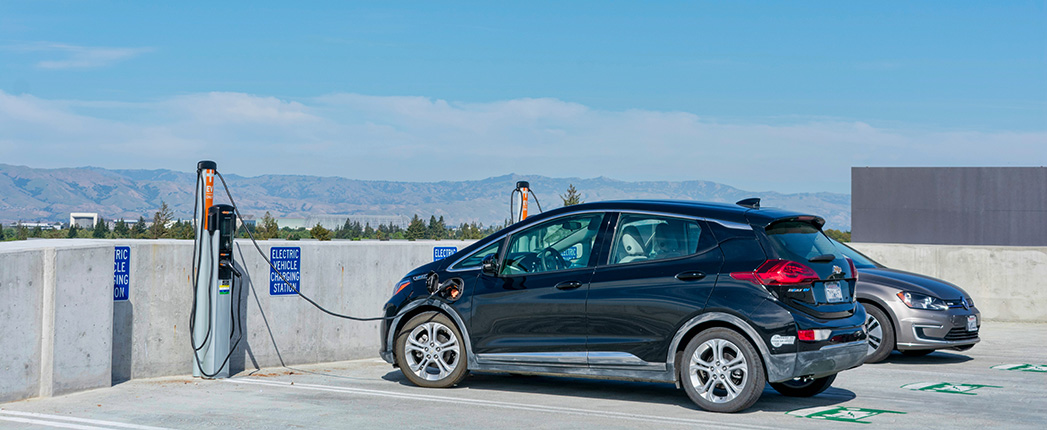
Electric vehicles could make up 90% of the United States’ passenger vehicle fleet by 2050 if the government and consumers become more aggressive about cutting carbon dioxide emissions, but they will be just 31% of the fleet if policies and practices evolve as they have been, BP predicted this week.
Released Monday, this year’s BP Energy Outlook covers three scenarios of how the world’s energy use will evolve: one assuming a rapid transition to policies that reduce carbon emissions from energy use by around 70% by 2050; a more rapid transition that BP refers to as net zero, in which shifts in societal practices reinforce policy changes to reduce carbon emissions by 95% by 2050; and a business-as-usual scenario in which assumes government policies and societal practices continue evolving as they have in recent years. The report included regional insights for the United States and Brazil.
United States
The outlook projects the EV share of the U.S. passenger vehicle fleet by 2050 would reach 31% under business-as-usual, 93% under rapid transition and 96% under net zero.
The outlook projects the U.S. share of global energy demand to decline from 17% in 2018 to 13% in 2050 under business-as-usual. Under the other two scenarios, it would fall further to 11%, primarily reflecting efficiency measures in buildings and electrification in transport.
The county’s energy consumption would decline by a compound annual rate of just 0.1% out to 2050 under business-as-usual. Slightly sharper rates of 1% to 1.1% are expected under the other two scenarios. Total energy consumption would decline by 4% over that period under business-as-usual, by 27% under net zero and by 30% under the rapid transition scenario.
Oil’s share of U.S. energy consumption is projected to decline from 38% in 2018 to 28% under business-as-usual, 17% under a rapid transition and 8% under net zero. Oil demand would plateau before 2025 in all scenarios, BP said, “from a combination of COVID-related behavioral change, efficiency and electrification.”
Natural gas’s share of the country’s energy supply is expected to increase from 31% in 2018 to 36% in 2050 under a business-as-usual approach, but decline to 25% under a rapid transition and 14% in net zero. The company projected that U.S. liquid natural gas exports would increase almost tenfold by 2050 in the business-as-usual and rapid transition scenarios.
Renewables are expected to make inroads in the coming decades, the outlook suggests, more noticeably in the rapid transition and net zero scenarios. From a 6% share of U.S. energy consumption in 2018, renewables are expected to grow to 30% in the business-as-usual scenario, 46% in a rapid transition and 63% under a net zero scenario.
Coal’s share of energy consumption in the U.S. is forecasted to drop from 14% in 2018 to 3% in 2050 under business as usual, and to nothing under the other two scenarios. By the same token, its share of U.S. power generation is also expected to decline, from 33% in 2018 to 3% in 2050 under business-as-usual, and to zero under the other scenarios.
Brazil
BP also examined the energy outlook for Brazil, which has a low carbon energy mix due to a very high hydro power base and heavy reliance on renewables to meet its energy demands.
Brazil’s share of global energy would increase slightly from 2.1% in 2018 to 2050 under all three scenarios: to 2.8% under business-as-usual, and to 3.1% to 3.2% in the other two scenarios.
The country’s energy consumption would decline slightly, by 4%, under a business-as-usual scenario, and more dramatically under a rapid transition and net zero scenario, at 30% and 27%, respectively.
The outlook projects that the South American country’s energy demand will decline at a 1.6% compound annual rate to 2050 under business-as-usual. The other scenarios differ little, declining at 1.5%.
Most of the country’s growth in primary demand to 2050 comes from the industry sector, which expands by 83% in a business-as-usual scenario, 101% in a rapid transition and 111% in a net zero scenario. Transport is the second largest in terms of energy demand growth by sector over that period.
The country remains one of the largest hydroelectric producers in the world, although this is expected to decline out to 2050. It accounted for 28% of Brazil’s energy mix in 2018. The outlook expects that to decrease to 21% under business-as-usual, 24% from a rapid transition and 26% under net zero scenario.
In all three scenarios, renewables’ share in Brazil’s energy mix is expected to expand rapidly, from 15% in 2018 to 32% under business-as-usual, 32% from a rapid transition and 54% in a net zero scenario.
Oil loses share in all three scenarios, declining from 39% in 2018 to 28% under business-as-usual, 14% in from a rapid transition and 7% under a net zero scenario.
Projections for Brazil’s CO2 emissions out to 2050 vary widely among the three scenarios: a 26% increase under business-as-usual, compared to declines of 41% under a rapid transition and 92% in a net zero scenario.
The 2019 BP Energy Outlook documents may be downloaded from the BP website.
For more coverage of electric vehicles and their impact on lubricants, subscribe to Lubes’n’Greases’ Perspective on Electric Vehicles.